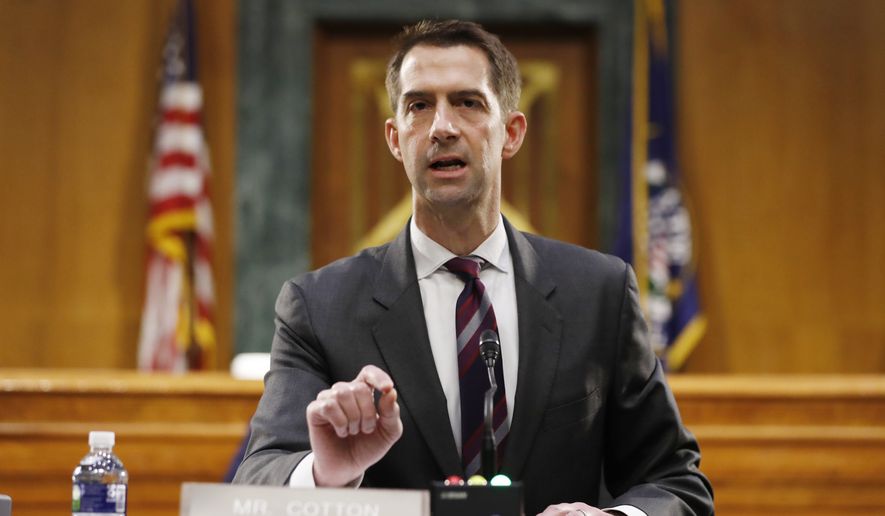Sen. Tom Cotton, Arkansas Republican, said Sunday there was “no question” that Chinese officials pressured the World Health Organization to downplay the risks of the novel coronavirus after it originated in Wuhan.
His comments came after the German newspaper Der Spiegel reported Saturday that Chinese president Xi Jinping urged WHO director-general Tedros Adhanom Ghebreyesus to delay a global warning on the disease in a Jan. 21 phone call, which the organization denied.
“I don’t know about all the specific details of those reports, but there’s no question that Xi Jinping and senior officials in the Chinese Communist Party were pressuring the WHO all the way back to December to undersell the risk of this virus,” said Mr. Cotton on Fox’s “Sunday Morning Futures.”
“They knew in China early on, probably as early as the early days of December, and that this virus was both highly contagious in humans and very deadly for certain people. Yet they wanted to save face,” he said.
In a statement, WHO denied the “false allegations” in the Der Spiegel report, which, citing German intelligence, said the Chinese leader also asked Mr. Tedros to hold back information on human-to-human transmission.
“Reports of a 21 Jan phone call between @DrTedros & President Xi are unfounded & untrue,” said WHO in a tweet. “They didn’t speak on 21 Jan & have never spoken by [phone]. Such inaccurate reports distract & detract from WHO’s & the [world’s] efforts to end #COVID19.”
The organization has been accused by Republicans of exacerbating the crisis by covering up for the Chinese, which WHO officials have denied, and waiting until March 11 to declare a pandemic.
In a now-infamous Jan. 14 tweet, WHO said, “Preliminary investigations conducted by Chinese authorities have found no clear evidence of human-to-human transmission of the novel #coronavirus.”
“In addition to saving face, they wanted once they realized this virus was going to cripple their own economy, that it did not remain limited to China,” Mr. Cotton said. “So the WHO has some real answers to provide to the world about why they bowed to Chinese pressure throughout December and January, and turned what could have been a local health emergency in Wuhan into a global pandemic.”
Sen. Cotton: No question that Chinese Communist Party officials were pressuring WHO https://t.co/baioUyDLLL @SundayFutures @FoxNews @TomCottonAR
— Maria Bartiromo (@MariaBartiromo) May 10, 2020
Statement on False Allegations in @derspiegel: Reports of a 21 Jan phone call between @DrTedros & 🇨🇳 President Xi are unfounded & untrue. They didn’t speak on 21 Jan & have never spoken by 📞
— World Health Organization (WHO) (@WHO) May 9, 2020
Such inaccurate reports distract & detract from WHO’s & the 🌍’s efforts to end #COVID19
Chinese officials and WHO have reported that the first apparent case of the novel coronavirus was diagnosed in Wuhan on Dec. 8, but White House trade policy adviser Peter Navarro said Sunday that “patient zero” actually emerged in November.
“We know that patient zero in China was about mid-November, it was in Wuhan,” Mr. Navarro said. “We know that ground zero had the P4 weapons lab, where the virus likely came from. For the next two months, we know that China hid the virus from the world behind the shield of the World Health Organization.”
The South China Morning Post last month traced the first case back to Nov. 17, citing government data viewed by the Hong Kong newspaper.
Meanwhile, cell-phone data collected from the area around the Wuhan Institute of Virology found that there was no mobile-phone activity in the lab’s high-security area from Oct. 7-24, according to NBC News, bolstering speculation that there may have been an emergency shutdown in response to the accidental release of the virus.
“If it is confirmed that roads around that lab were shut down for a number of days in mid-October, it is highly coincidental that there was a major shutdown of those roads at about the time one might have expected this virus to first get transmitted to humans, whatever the origins may have been,” said Mr. Cotton.
He said such information would come as “another piece of circumstantial evidence that there was some kind of accident or outbreak from those labs, not from the seafood market or anywhere else.”
“That’s why it’s so important we get to the bottom of this data,” Mr. Cotton said.
More than four million people worldwide have been sickened by the disease and 281,399 have died, according to Sunday data from the Johns Hopkins Coronavirus Resource Center.
• Valerie Richardson can be reached at vrichardson@washingtontimes.com.




Please read our comment policy before commenting.